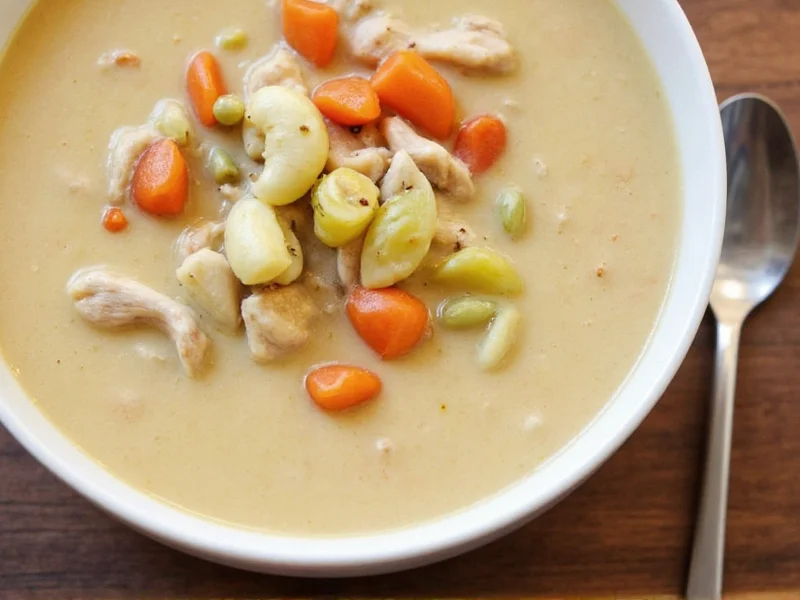Cream of chicken soup represents one of the most versatile pantry staples in American cuisine. This classic preparation transforms simple ingredients into a rich, comforting dish that has maintained popularity since the early 20th century. Unlike clear chicken broth, cream of chicken soup achieves its signature texture through careful thickening and emulsification techniques that create a smooth, cohesive liquid without lumps or separation.
Core Ingredients and Preparation Method
The foundation of authentic cream of chicken soup begins with quality chicken stock, preferably homemade from simmered chicken bones and aromatics. The thickening process involves creating a roux—cooking equal parts butter and all-purpose flour until golden—then gradually whisking in the hot stock. This careful incorporation prevents clumping and ensures a silky consistency. After the base thickens, cooked chicken meat (usually poached breast or thigh), cream or whole milk, and seasonings like salt, pepper, and herbs complete the mixture.
| Ingredient | Traditional Role | Common Substitutes |
|---|---|---|
| Chicken stock | Flavor foundation | Low-sodium broth, bone broth |
| Butter and flour | Roux for thickening | Cornstarch slurry, arrowroot |
| Heavy cream | Richness and texture | Whole milk, coconut milk |
| Cooked chicken | Protein element | Shredded turkey, mushrooms |
Distinguishing Cream of Chicken from Similar Preparations
Many confuse cream of chicken soup with chicken bisque or regular chicken broth. The critical difference lies in texture and preparation. While chicken broth remains a clear, unthickened liquid, cream of chicken soup achieves its characteristic thickness through the roux method. Chicken bisque typically uses a different thickening approach (often pureed vegetables) and incorporates more cream, resulting in an even richer product. Understanding what makes cream of chicken soup different from condensed chicken soup is essential—condensed versions contain less liquid and require dilution before serving.
Homemade vs. Canned Variations
Commercial canned cream of chicken soup often contains modified food starch, MSG, and preservatives to maintain shelf stability and consistent texture. When exploring how to make cream of chicken soup from scratch, home cooks gain control over ingredients and can avoid additives. The homemade version typically features brighter chicken flavor, more discernible meat pieces, and a fresher taste profile. For those seeking cream of chicken soup without MSG, preparing it at home remains the most reliable option.
Culinary Applications Beyond the Bowl
Cream of chicken soup's versatility extends far beyond being served as a standalone dish. It serves as the base for numerous comfort food classics including chicken pot pie filling, green bean casserole, and creamy pasta sauces. When considering what to use instead of cream of chicken soup in recipes, understanding its functional role—providing both flavor and thickening properties—is crucial. Many casseroles rely on its emulsifying qualities to create cohesive, non-watery results.
Nutritional Profile and Dietary Considerations
A standard serving (½ cup) of traditional cream of chicken soup contains approximately 100-120 calories, 4-6g fat, 8-10g carbohydrates, and 3-4g protein. The dairy content contributes saturated fat, while the roux adds carbohydrates. For those exploring healthy cream of chicken soup recipe options, substitutions like using skim milk instead of cream, reducing butter in the roux, or incorporating vegetable purees for thickness can create lighter versions without sacrificing texture.
Storage and Shelf Life Guidelines
Properly stored homemade cream of chicken soup remains fresh for 3-4 days in the refrigerator. For longer preservation, freezing in airtight containers works effectively for up to 3 months. The dairy content means thawing should occur gradually in the refrigerator to prevent separation. Understanding how long does cream of chicken soup last in the fridge helps prevent food waste while maintaining quality. Commercial canned versions maintain quality for 18-24 months unopened but should be consumed within 3-5 days after opening.
Global Variations and Cultural Adaptations
While cream of chicken soup is particularly associated with American cuisine, similar preparations exist worldwide. French cuisine features soupe à la crème de poulet, typically lighter and more herb-forward. In Latin American cooking, sopa crema de pollo often incorporates regional spices and vegetables. These international variations demonstrate how the basic concept of creamy chicken soup adapts to local tastes while maintaining its essential characteristics.











 浙公网安备
33010002000092号
浙公网安备
33010002000092号 浙B2-20120091-4
浙B2-20120091-4